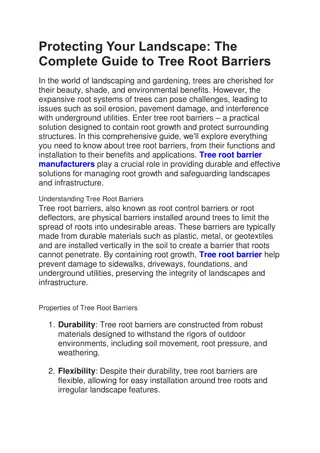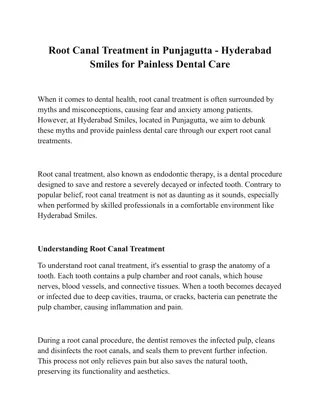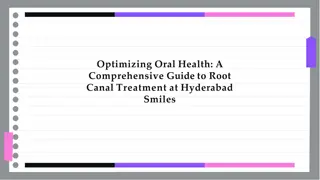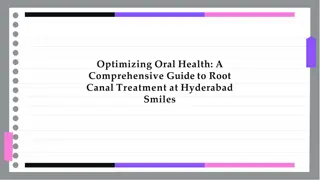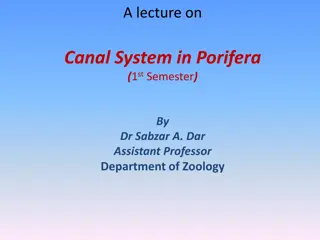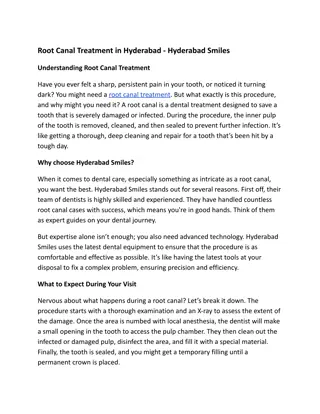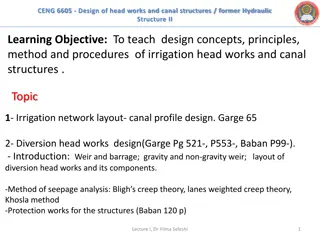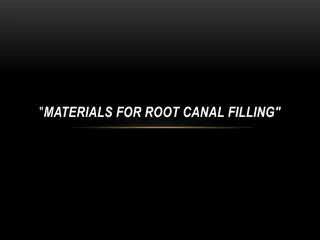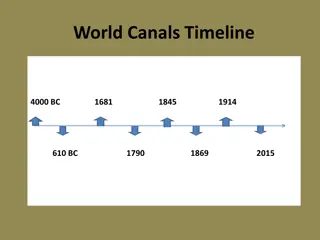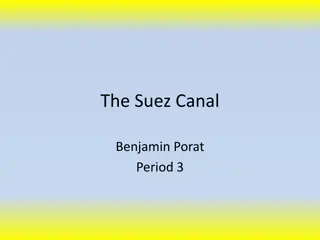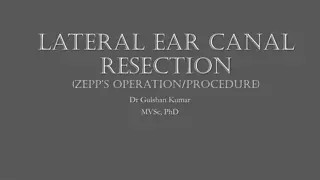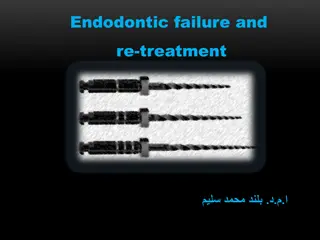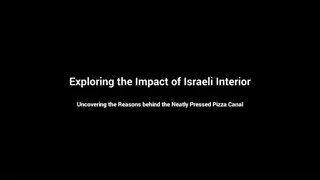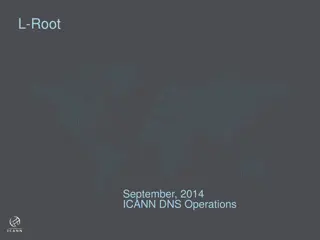Understanding Endodontic Mishaps in Root Canal Treatment
Endodontic mishaps or procedural accidents are unfortunate occurrences that can happen during root canal treatment, ranging from inattention to detail to unpredictable events. These mishaps can affect the prognosis and may require corrective measures. Classification of mishaps includes accidents during access preparation, cleaning and shaping, and obturation. Management involves recognizing, correcting, and preventing mishaps to ensure the best outcome for the patient. When accidents occur, informing the patient, determining corrective procedures, and evaluating alternative treatment options are essential steps. Access-related mishaps, caused by inattention or misdiagnosis, require proper recognition and correction to address any resulting issues effectively.
Download Presentation

Please find below an Image/Link to download the presentation.
The content on the website is provided AS IS for your information and personal use only. It may not be sold, licensed, or shared on other websites without obtaining consent from the author. Download presentation by click this link. If you encounter any issues during the download, it is possible that the publisher has removed the file from their server.
E N D
Presentation Transcript
Endodontic mishaps or procedural accidents are those unfortunate occurrences that happen during treatment, some owing to inattention given to detail otherwise totally unpredictable. INGLE: Those unfortunate occurrences that happen during treatment, some owing to inattention to detail, others totally unpredictable. WALTON & TORABINEJAD : Unwanted or unforeseen circumstances during root canal therapy that can affect theprognosis. 2
Classification According to Walton &Torabinejad Procedural accidents during access preparation 1. Accidents during post space 4. preparation Accidents during cleaning & shaping 2. Ledge formation 1. Creating an artificialcanal 2. Root perforations 3. Separatedinstruments 4. Other accidents 5. Accidents duringobturation 3. Underfilling 1. Overfilling 2. Vertical rootfractures 3. 3
According toIngle Access related 1. 2. 3. I. Obturationrelated 1. Over or underextended root canal fillings 2. Nerve paresthesia 3. Vertical rootfractures III . Treating the wrong tooth Missed canals Damage to existing restoration Access cavity perforations Crown fractures 4. 5. Miscellaneous 1. 2. 3. 4. IV. Post space perforation Irrigantrelated Tissue emphysema Instrument aspiration and ingestion Instrumentationrelated 1. Ledgeformation 2. Cervical canal perforations 3. Midrootperforations 4. Apical perforations 5. Separated instruments and foreign objects 6. Canal blockage II. 4
MANAGEMENT OF A MISHAP I. Recognition of a mishap - be by radiograph or clinical observation or as a result of a patients complain II. Correction of a mishap - depending on the type and extend of procedural accident III. Re-evaluation of the prognosis tooth involved IV. How to prevent a mishap 5
When an accident occurs during root canal treatment -The patient should be informed about Procedures necessary for correction The effect of this accident on prognosis Alternative treatment modalities The incident
Inattention on the part of the dentist Cause Misdiagnosis Error may be detected after the rubber dam has been removed. Patient continues to have symptoms after treatment Recognition Correction Appropriate treatment of both teeth: The one incorrectly opened The one with the original pulpal problem 8
PREVENTION Mistakes in diagnosis can be avoided by obtaining at-least 3 good pieces of evidence supporting the diagnosis. Marking the tooth to be treated before isolating it with rubber dam. Obtaining as much information as possible before making the diagnosis.
Mistakes in diagnosis can be avoided by, obtaining at least three good pieces of evidence supporting the diagnosis Radiograph showing a tooth with an apical lesion. Lack of response to electric pulp testing Draining sinus tract leading to the tooth apex proved radiographically with a GP point inserted in the tract.
MISSED CANALS Cause Some root canals are not readily apparent or easily accessible Anatomical Failure to remove cervical ledges - prevents straight line entry into the canal or cover up additional canals Failure to adequately search for these additional canals. Dentist Related Lack of knowledge about root canal anatomy.
Recognition During treatment, an instrument or filling material may be noticed to be other than exactly centered in the root. Some cases, recognition may not occur until failure is detected. Mesial roots of maxillary molars and distal roots of mandibular molars - commonly missed canals. NaOCl can be used to detect canals effervescence test CorrectionRetreatment is appropriate and should be attempted before recommending surgical correction.
Prognosis is reduced - most likely result in treatment failure PROGNOSIS PREVENTION Significant amount of failure are due to missed canals Thorough knowledge of the morphology of the tooth Interpretation of radiographs through mesial / distal angulation Computerized digital radiography, magnifying loupes, microscopes, endoscopes. Adequate coronal access - Follow principles of access cavity preparation DG-16 explorer / Micro openers 13
DAMAGE TO EXISTING RESTORATIONS Endo-treatment of a tooth with existing porcelain crown is challenging. Crown may chip off even with the most careful approach While preparing access cavity Placing rubber dam clamp on the margins Correction Minor porcelain chips can be at times repaired by bonding composite resin to crown 14
PREVENTION The rubber dam is released from the wings and positioned with the rubber between the jaws of the retainer and the restoration to provide a buffer. Remove crown with special device called Metalift crown and bridge system Remove permanently cemented crown before treatment Specialized crown pliers can be used to remove restorations Avoiding placing clamp directly on the margin UltrasonicVibration 15
ACCESS CAVITY PERFORATIONS Happens during the search for canal orifices. Can occur either peripherally through the sides of the crown or through furcation. Recognition If the access cavity perforation is Above PDL attachment Presence of leakage into the access cavity is often the first indication of an accidentalperforation. Into PDL Bleeding into the access cavity is often the first indication of an accidental perforation. 16
Cause Failure to identify the angle of the crown to the root and the angle of the tooth in the dental arch. Ex: Access through crowned teeth. Maxillary lateral incisors and mandibular first premolars Using a surgical length bur Misidentification of canals 17
Correction Coronal walls above the alveolar crest can be repaired intracoronally without surgical intervention. Perforations into periodontal ligament should be done as early as possible to minimize injury to the tooth s supporting tissues. Materials used for these perforations - GIC, MTA, Super EBA, Tricalcium phosphate, Calcium hydroxide paste, amalgam or haemostatic agents such as gel foam. 18
Prognosis Location Time Adequacy of seal Perforation size Accessibility to main canals Location Time Adequacy of seal Perforation size Depends on: 19
PREVENTION Bur penetration for both depth and angulation can be confirmed with radiographs Proper bur alignment with the long axis of the tooth Knowledge about the morphology Adequate access preparation 20
INSTRUMENTATION RELATED MISHAPS LEDGE FORMATION An artificially created irregularity on the surface of the root canal wall that prevents the placement of instruments to the apex of an otherwise patent canal.
RECOGNITION Root canal instrument can no longer be inserted into the canal to full working length. Loss of tactile sensation of the tip of the instrument binding in the lumen. Instrument point hitting against a solid wall Radiograph with instrument in place. 22
Inadequate access preparation Inadequate irrigation / lubrication Excessive enlargement of curved canal with files Cause Packing debris in the apical portion of the canal Anatomic complexities - roots curved towards the buccal or lingual side. Unsuspected canal aberrations in canal anatomy Forcing and driving the instrument into the canal Attempting to retrieve broken instruments Attempting to prepare calcified root canals 23
Correction Locating theledge Irrigate, smaller instruments are preferred. No. 10 or 15 with a distal curve at the tip can be used Pointed towards the wall opposite to theledge Tear shaped silicone stops can be used. Watch-windingmotion If resistance is felt, retract slightly, rotate and advance again,until it bypasses and reach apically. Confirmed with a radiograph If ledge cannot be bypassed, then clean, shape and obturate till obstruction. 24
CORRECTION Alternative treatment procedures includes Retrograde filling through surgery Intentional replantation Hemisection / apisectomy Extraction 25
PREVENTION Proper examination of the diagnostic radiographs. Awareness of canal morphology Frequent recapitulation and irrigation Precurving the instrument and not forcing it. Using instruments with not cutting tip Using NiTi files in case of curved canals Flex R files Safety Hedstrom files Modified instruments: Flexofile 26
Prognosis Failure of root canal associated with ledging depends upon: Amount of debris left in the un instrumented canal Unfilled portion of the canal 27
ROOT PERFORATIONS Perforations in all locations can be caused by 2 main errors Creating a ledge in the canal wall during initial preparation and perforating through the side of the root at the point of obstructions / root curvature. Using too large or too long an instrument and either perforating directly through the apical foramen or wearing a hole in the lateral surface of the root by over instrumentation.
Perforations can be either Cervical Middle Apical
CERVICAL CANAL PERFORATION Locating and widening the canal orifice. Cause Inappropriate use of Gates-Glidden burs. Recognition Sudden appearance of blood. Magnification with either loupes, an endoscope, or a microscope is very useful. Confirmed : place a small file and take a radiograph of the tooth. 30
Correction Hemostatics to controlbleeding. Small area : sealed from inside the tooth Large area : seal from inside, then surgical repair Materials used: Calcium Hydroxide, Collagen, Calcium Sulfate, Freeze-dried Bone, MTA Where esthetics is a concern, a calcium sulfate barrier along with composite restoration is generally used Super EBA have been used when esthetics not an issue. Presently MTAis rapidly becoming the barrier/ restorative of choice for repairing non- esthetic coronal one-third defects because of its many desirable attributes. 31
Prognosis Usually Reduced Surgical correction is required if a lesion / symptoms develops. Size Location Depends on Length of time Ability to seal Accessibility to main canal Existing periodontal condition 32
Prevention Reviewing each tooth s morphology prior to entering its pulp space. Thorough examination of pre-operative radiographs is the paramount step to avoid this mishap. Checking the long axis of the tooth and aligning the long axis of the access bur with the long axis of the tooth - tipped tooth. Following principles of access cavity preparation, adequate size and location, both permitting direct access to the root canals. 33
Mid-Root Perforation Cause Perforating when a ledge hasformed Along the inside curvature of the root as the canal is straightened out - canal stripping (Ex: Distal wall of the mesial root of the mandibular first molar) Difficult access Limited visibility Uncertainity of moisture free environment 34
Recognition Stripping is easily detected by the sudden appearance of hemorrhage in a previously dry canal. Paper points placed into the canal Sudden complaint by the patient. Apex locators 35
CORRECTION These defects are ovoid in shape and typically represent relatively large surface area to seal. Access to midroot perforation is most often difficult, and repair is not predictable. Successful repair depends upon the adequacy of the seal established by the repair material. The repair should be immediate, to protect the perforated site from saliva and other contaminants. Barrier material of choice is MTA. Two-step method: canals obturated and then defect is repaired surgically
PROGNOSIS Usually Reduced Chances of micro-leakage / fracture Prevention Careful use of rotary instruments. Anticurvature filing 37
APICAL PERFORATION Cause Straightcanal :- Inaccurate WL & instrumenting beyond apex Curved canal - Ledging, Apical Transportation or Apical Zipping Recognition Patient suddenly complains of pain during treatment. Canal becomes flooded with hemorrhage. If tactile resistance of the confines of the canal space is lost. Confirmation by radiograph. A paper point inserted to the apex will confirm a suspected apical perforation. 38
Zipping(Elliptication) Transportation of the apical portion of thecanal ie. an elliptical shape formed in the apical foramen during preparation of curved canals. The terms teardrop and hour-glass shape are used to describe the resulting shape of the zipped apical part of the root canal Creation of an elbow is associated with zipping at the narrow region of the root canal at the point of maximum curvature Ie. the irregular widening that occurs coronally along the inner aspect and apically along the outer aspect of the curve. 39
CORRECTION Overinstumentation : Re-establish the WL and enlarge with larger instrument. Apical barrier: Ca(OH)2, MTA, Dentin Chips, Hydroxyapatite Apical Perforation : Negotiate Perforationsite as the new apical opening and obturation is done to seal of the foramen. Surgery is necessary, if a lesion present apically. 40
SurgicalApproach: A combined intracoronal and surgical approach involves repairing the defect intracoronally, then reflecting a surgical flap to remove the inevitable overextension of the repair material from the periodontal space. In case of failing furcation repairs Intentional Replantation Bicuspidation can be considered as treatmentoptions. Hemi-Section 41
Instrument Separation Files & Reamers most commonly involved Using a Stressed instrument Placing exaggerated bends Forcing a file before canal has been opened sufficiently. Cause Inadequate access Anatomy of the canal Instrument is advanced into the canal until it binds, and efforts to remove it . Manufacturing defects 42
RECOGNITION Shortened instrument Radiographic confirmation Loss of WL CORRECTION There are three approaches to treatment. Attempt to remove the instrument Attempt to by pass it Prepare and obturate up to the separated segment. It will vary depending upon the location and nature of the broken instrument. 43
If one third of the overall length of an obstruction can be exposed and /or Instrument that lie in the straight portion of the canal : Retrieval Is Possible. Instrument lies partially around the canal curvature and if access canbe established to its most coronal extent : removal is Difficult But Still Possible. If the entire segment of the broken instrument is apical to the curvature if the canal and safe access cannot be accomplished : Removal Impossible. 44
RETRIEVAL TECHNIQUES Checking for the mobility of the instrument If lying loosely in the coronal third- Using microscopes, K files or H files are placed between the instrument and the dentinal wall, to bypass the obstacle. NaOCl and urea peroxide Effervescence Or Bubbling Effect makes the instrument to float. Grasping the file - Micro Needle Forceps, Steiglitz / a Hemostat 45
RETRIEVAL TECHNIQUES Wedged instruments in coronal third Masseran KIT Useful for removing metallic objects from root canals. It contains a series of tubular trephine drills,& 2 sizes of tubular excavator. Technique First creating a space in the root canal around the coronal 2 mm of the metallic object, so that the excavator tube will pass over it. Then the excavator plugger, a locking rod in the tube is screened down, locking the metallic object against a knurled ring in the tube wall. This mechanism provides adequate retention for removal of most metallic object and instruments. 46
Instrument Retrieval System (IRS) Endo extractors : They grasp the instrument with cyanoacrylate and not by friction. Endo safety system: Also uses trephine burs. These trephines are smaller in diameter & the extractors use different mechanisms for grasping instruments 47
Ultrasonicinstruments Different sizes and angles of ultrasonic tips are available for this purpose. Ex: ProUltra Endo: 1,2,3 ; ProUltra Endo: 6, 7, 8 The tip is placed on the staging platform between the exposed end of the file and the canalwall. Precisely removes dentin and progressively exposes the coronal aspect of the fractured file. Vibration in CCW direction applies unscrewing force to the file that will aid in loosening the file. Occasionally they will appear to jump out of the canal It is wise to keep cotton or paper points in other canals to prevent the removed fragment from falling into them. 48
Middle 1/3 of the canal Micro needle forceps and H file Ultrasonic tips such as Slim Jim ,CT4 & UT4 can be used. Apical Third Instruments cannot be grasped directly. Drilling with instruments remove excess dentin Use of RC prep /NaOCl H file Sonic instrumentation 49
Failing to retrieve the instrument : Within the canal : Bypassed Canal is filled But risk of perforation Within the canal : Cannot be bypassed Prepare and fill the canal till the level of separation Instrument seals close to the apex and apical area is normal, then keep under evaluation. If area of rarefaction persists, then apical surgery. If instrument extends pass the apex Cleaning, shaping and filling Apical surgery and retro-filling if indicated 50


